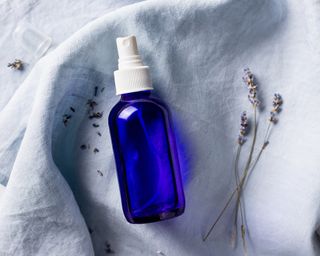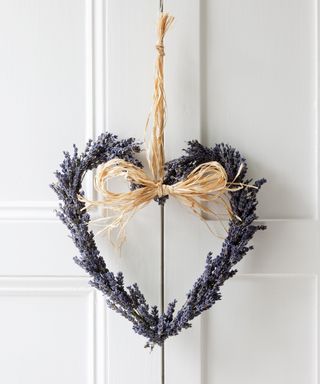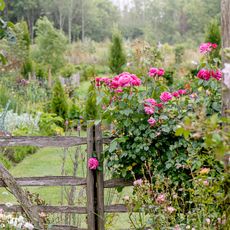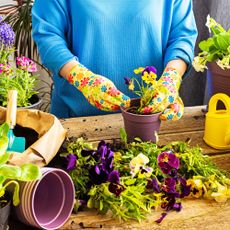8 Lavender Craft Ideas To Savor Your Garden Harvest
Home-grown lavender has endless uses for its enticing aroma, flavor, and therapeutic benefits. Discover creative crafts to make your harvest last for months.


With its vibrant blooms, delicious aroma, and therapeutic properties, lavender is a prized herb. However, it needn’t be confined to the garden. Growing lavender opens up a world of possibilities for creating craft projects that can enhance your home and well-being.
Harvesting lavender from the garden allows you to harness its calming qualities to enjoy for months on end. Depending on the project, lavender can be used fresh or dry.
To capture its essential oils and preserve its fragrance, lavender is best harvested in the morning after the dew has dried, but before the heat of the day. Aim to cut the stems just as the flowers begin to open, as this is when they are most fragrant and contain the highest concentration of oils.
Drying lavender is a straightforward process that ensures the flowers retain their color and aroma. Bundle 10-15 stems together and secure them with a rubber band or string. Hang the bundles upside down in a dark, dry, and well-ventilated area for about two weeks. This method preserves the essential oils and prevents mold growth.
Once your lavender is dried, it can be used in a variety of ways that make the most of its delightful aroma and therapeutic qualities. Whether you are an experienced gardener or a crafting enthusiast, these projects offer a rewarding way to enjoy the many benefits of lavender.
1. Lavender Oil

Infusing oil with lavender is a great way to preserve the flowers’ aroma for long periods. Lavender oil is the most widely used essential oil and has numerous therapeutic qualities, including promoting restful sleep and acting as an antioxidant and anti-inflammatory.
Making essential oils is easy to do and the resulting product can be used in the bath, in cosmetics, or in oil diffusers.
Gardening tips, videos, info and more delivered right to your inbox!
Sign up for the Gardening Know How newsletter today and receive a free copy of our e-book "How to Grow Delicious Tomatoes".
- Put 2-4 cups of fresh lavender flowers into a large jar.
- Fill with your chosen carrier oil, covering the flowers – jojoba and sunflower oil are good choices.
- Put the lid back on and place the jar in a warm place, avoiding direct sunlight, for at least 48 hours.
- Shake the jar occasionally to help the flowers infuse the oil.
- Using cheesecloth, strain the oil into a fresh jar.
- You may need to repeat this process two or three times to achieve your preferred level of strength, infusing a fresh batch of flowers each time.
- Store the oil in a dark glass bottle in a cool, dark spot.
2. Linen Water

Once you have made your own lavender essential oil, you can use it to make lavender water – this is ideal for use when ironing, as it imparts a delicious fragrance. Alternatively, leave out the alcohol and add it to a spray bottle to use as a refreshing face and hair mist.
- Fill a jug with 3 cups of distilled water, then add about 20 drops of homemade lavender oil.
- If making linen water, add 6 tablespoons of vodka.
- Decant the solution to a spray bottle, or use it directly in the iron.
3. Therapeutic Teabags

Lavender tea is a wonderful bedtime drink, aiding peaceful sleep, calming nerves, and even easing headaches. While you can make tea using flowers fresh from the garden, turning dried lavender into tea bags is an enjoyable craft.
Only the lavender flowers are suitable for turning into tea, so don’t use the foliage. The flowers will need to be dry, otherwise they will go moldy in the teabag.
If you like, you can combine lavender with other therapeutic flowers or herbs, such as chamomile or rosemary.
- Cut up a piece of cheesecloth into squares measuring around 3x3 inches (8x8cm).
- Add 1-2 teaspoonfuls of dried lavender flowers to each fabric square, heaping it in the middle.
- Take the edges of the fabric, and gather at the top, forming a ball or pouch with the lavender.
- Tie tightly with a thin piece of natural twine, around 4-5 inches (10-13cm) long.
- Attach the other end of the string to a kraft gift tag, which you can label or stamp as desired.
- To make your tea, steep the teabag in boiling water for 5-10 minutes. Remove the teabag and, if desired, sweeten with honey.
4. Sugar Syrup

Lavender syrup makes a delicious addition to cocktails and soft drinks. It’s very easy to make, but the syrup will be extremely hot while being boiled, so take health and safety precautions.
- In a large saucepan, combine a cup of water and 2-3 tablespoons of lavender flowers – these may be fresh or dried.
- Bring the mixture to a boil, then reduce the heat to a gentle simmer, and gradually add 1 cup of sugar, stirring constantly until it is fully dissolved.
- Simmer for 15 minutes.
- Turn off the heat and allow the mixture to cool for 30-60 minutes, checking the flavor every 15 minutes until you are happy with the intensity.
- Strain the mix into a bottle and store in the refrigerator.
5. Lavender Sachets

Lavender sachets are perfect for freshening up clothes drawers. They are made with the addition of rice, which adds weight to the sachets and absorbs the intense aromas.
The sachets can even be warmed in the microwave to make a therapeutic heating pad that soothes aches and pains.
- In a bowl, combine dried lavender and dried rice to a ratio of two parts lavender to one part rice.
- Cut out two pieces of fabric to your desired size – 4x4 inches (10x10cm) is a nice size. The fabric can be decorative cotton or a rustic plain linen. The important thing is that the fabric is breathable.
- With right sides together, sew the edges of three sides of the sachet, either by hand or on the sewing machine. Turn it the right way out.
- Fill your sachet with the rice and lavender mix, then sew the remaining edge by hand, folding the edges inwards for a neat finish. Alternatively, close the sachet by tying it tightly with a ribbon.
6. Summer Wreath

Make a lavender wreath to add a pretty, summery touch to your front door. Use freshly harvested lavender, so it dries in its wreath shape. Harvest stems just before the flowers begin to open in full.
- Cut lavender stems, at least 4 inches (10cm) in length.
- Create small bundles of lavender stems, tying them together with florist wire or string.
- Use a metal wreath form and florist wire to securely attach the bundles in a wring shape.
- Overlap each bundle with the next to cover up the wire and stems.
- Add a wire loop to one side of the wreath to hang, or lay the wreath flat to act as a table centerpiece.
7. Lavender Wand

A hand-woven lavender wand is a traditional French handicraft that can be used to add a decorative fragrant touch to rooms, or even hung in closets as a moth repellent.
They are made by weaving the stems together with ribbon, which then acts as a cage for holding the flowers inside.
- Harvest fresh lavender stems that have just begun to open. These need to be at least 12 inches (30cm) long.
- Strip the leaves from the stems, but leave the flower heads intact. Bundle them together, tying at the top with a piece of thread, just below the flowers. Tie a length of ribbon at least 12 inches long around this thread.
- Bend the stems out and over the lavender flowers, so that they are enclosed inside, then weave the ribbon between the lavender stems – this forms a decorative design. The ribbon needs to be fairly taut to hold the flowers inside.
- Once all the flowers have been covered, tie the ribbon around the base and tie it off.
- Neatly trim the ends of the lavender stalks so they are all the same length.
8. Bath Salts

Soothe aching muscles and relax at the end of the day in a lavender-infused bathtub. It’s easy to make your own spa-inspired bath salts, and they can also be added to a mason jar to give as a gift.
- Mix together 1 cup Epsom salts with 1 cup sea salts – pink sea salt flakes make a pretty addition.
- Add about 4 tablespoons of dried lavender flowers and 20-30 drops of your homemade lavender essential oil, then give it a good stir.
- Pour into an airtight mason jar.
- When filling the bath, add about a quarter of a cup to the running water. Soak and enjoy!

Melanie is an experienced gardener and has worked in homes and gardens media for over 20 years. She previously served as Editor on Period Living magazine, and worked for Homes & Gardens, Gardening Etc, Real Homes, and Homebuilding & Renovating. Melanie has spent the last few years transforming her own garden, which is constantly evolving as a work in progress. She is also a passionate organic home grower, having experimented with almost every type of vegetable at some point. In her home, Melanie tends to an extensive houseplant collection and is particularly fond of orchids.
-
 New Ways To Use Classic Garden Plants – For A Modern Landscape With A Touch Of Nostalgia
New Ways To Use Classic Garden Plants – For A Modern Landscape With A Touch Of NostalgiaThe 'Nostalgia Gardening' trend uses classic garden plants in new ways to add interest to your landscape and harken back to gardens of the past. Old is new again!
By Mary Ellen Ellis
-
 New England April Garden Checklist: What Flowers, Shrubs, Veggies & Herbs To Plant Now
New England April Garden Checklist: What Flowers, Shrubs, Veggies & Herbs To Plant NowLearn what crops and ornamentals to plant in April for a thriving garden in Connecticut, Maine, Massachusetts, New Hampshire, Rhode Island, or Vermont.
By Ellen Wells